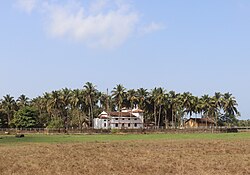Salcete Saxtti/Xaxtti Salcette | |
|---|---|
Taluka (subdistrict) | |
 Salcete countryside | |
 Location of Salcete in South Goa, Goa | |
| Coordinates: 15°12′45″N74°04′24″E / 15.212450°N 74.07323°E | |
| Country | |
| State | Goa |
| District | South Goa |
| Headquarters | Margao |
| Settlements (as of 2011) | 2 cities 11 towns 35 villages |
| Government | |
| • Deputy Collector | Jyoti Kumari, IAS [1] |
| • Talukadar [1] | Prataprao Gaunkar |
| Population (2011) [2] | |
• Total | 294,504 |
| Demonym | Saxtticar/Xaxtticar |
| PIN | 4036XX, 4037XX |
| Vehicle registration | GA-08 |
Salcete (Konkani: Saxtti/Xaxtti) is a subdivision of the district of South Goa, in the state of Goa, situated by the west coast of India. [3] The Sal River and its backwaters dominate the landscape of Salcete. [4] Historically, the sixty-six settlements south of the Zuari River formed the original Salcette territory. [5] Salcete forms a part of the bigger Konkan region that stretches along the western shoreline of peninsular India. [6]
Contents
- Etymology
- History
- Salcette territory
- Historical Salcette
- Contemporary Salcete
- Demographics
- Religion
- Languages
- Notes
- Citations
- References
- External links
In erstwhile Portuguese Goa, the Salcette concelho (county) located in the Velhas Conquistas (Old Conquests) was co-terminous with the undivided Salcette territory (Mormugao and Salcete talukas ). [7] In 1917, the concelho was bifurcated into the present-day talukas of Mormugao and Salcete. [8] The contemporary Salcete taluka has been classified as a rurban area. [9] Margao serves as the administrative headquarters of both Salcete taluka and the South Goa district. [10]
